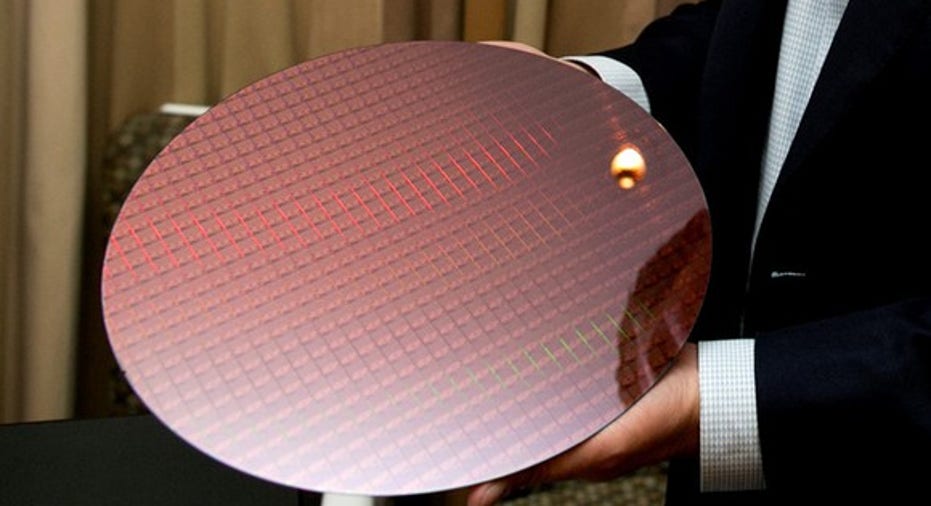How Intel Corporation Boosted Client Computing Group Profits By 30% in 2016

One of the highlights of microprocessor giant Intel's (NASDAQ: INTC) 2016 financial results was that the company saw a more than 30% improvement in the operating income of its Client Computing Group (CCG).
In the company's freshly published form 10-K filing, there is a detailed breakdown of what exactly drove the company's operating profit in this segment. In this column, I'd like to explain that breakdown.
An Intel employee holding a wafer of 14-nanometer chips. Image source: Intel.
Lower unit costs
In moving from 2015 to 2016, Intel reported that due to "lower CCG platform unit cost[s]," CCG saw a $1.25 billion improvement in operating profit. Remember that back in 2015, Intel saw higher platform unit costs as it transitioned from its mature, high-yielding 22-nanometer manufacturing technology to its less mature, relatively low-yielding 14-nanometer manufacturing technology.
The improvement in platform unit costs here, then, is seemingly thanks to an improvement in the company's manufacturing yields (and thus cost structure) of its 14-nanometer technology -- better late than never.
Lower operating expenses
Even before the company announced its restructuring actions nearly a year ago, Intel had already made it clear that it was cutting back operating expenses associated with its mobile business, which is part of Intel's CCG.
Then, with the announcement of the restructuring actions, Intel clearly decided to accelerate the reduction in its CCG-related operating expenses.
A large part of the year-over-year boost was due to those lowered operating expenses, which Intel says were good for $905 million in savings.
More sales, more profit -- and "other"
Next, Intel says that $625 million of the profit improvement was due to "higher gross margin from CCG platform revenue." In other words, because revenue grew, and since that revenue clearly came at a positive gross profit margin, it contributed positively to operating profit.
And, finally, Intel says it enjoyed a $345 million improvement in operating profit because of "other." The 10-K filing doesn't specify exactly what those "other" factors are, though, so we'll have to leave it at that.
Now, for the bad news
Although Intel saw a large boost in CCG's operating profit due to several positive factors, there was something that partially detracted from the good news: increased factory start-up costs related to its 10-nanometer manufacturing technology.
That hurt CCG operating income to the tune of $645 million.
Looking toward the future
Intel didn't give explicit operating profit guidance for CCG in 2017 other than the fact that it expects operating profit in CCG to outgrow revenue (which Intel expects to decline at a roughly mid-single-digit clip in 2017 relative to 2016 levels).
For 2017, I think there's a good chance we'll see further reductions in the company's unit costs as its manufacturing yields on 14-nanometer technology improve (for reasons beyond the scope of this column, there is evidence in the form 10-K filing to suggest that 14-nanometer yields/costs still have room to improve).
There is the potential for that good news to be partially offset by the initial shipments of products built on its 10-nanometer technology, but it's not likely that such chips will represent significant volume shipments this year (management said at its Feb. 9 Investor Meeting that it expects real volume shipments of 10-nanometer products in 2018).
There's probably further room for operating expense reductions -- after all, Intel said it would achieve the targeted run-rate operating expense savings from its restructuring actions by mid-2017.
As far as bad news goes, 10-nanometer factory start-up costs could prove a further headwind to gross profit here. Additionally, if Intel sees a decline in CCG unit volumes without a boost in average selling prices to counteract that decline, like what happened in 2016, that could be a year-over-year headwind as well.
Investors should be able to get a better sense of how this business's revenue and, ultimately, operating profit will turn out for the full year after a quarter or two of results. Stay tuned.
Offer from The Motley Fool: The 10 best stocks to buy nowMotley Fool co-founders Tom and David Gardner have spent more than a decade beating the market. In fact, the newsletter they run, Motley Fool Stock Advisor, has tripled the S&P 500!*
Tom and David just revealed their 10 top stock picks for investors to buy right now.
Click here to get access to the full list!
*Stock Advisor returns as of 1/30/2017.
Ashraf Eassa owns shares of Intel. The Motley Fool recommends Intel. The Motley Fool has a disclosure policy.